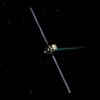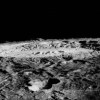
e-Tutorials
E-tutorials are designed to inform educators about available NASA science materials and information on space, Earth, biological, and physical sciences. The podcasts and supportive web pages collect a variety of materials all in one place for educators. See how you can launch some exciting curriculum supplements in your classroom!
 View Light
View LightVisible light is just a small part of the electromagnetic spectrum. Scientists use various telescopes to detect the full range of electromagnetic waves emitted by objects in space. NASA can help you teach your students that there's more to light than what they can see.
 View Newton's Law
View Newton's LawThis e-Tutorial on the laws of motion explains Newton's three laws of motion with some help from extreme sports, driver's education, french fries, ketchup, and the astronauts on the International Space Station.
 View Earth Science
View Earth ScienceEarth is the only planet we know of that sustains life. From a vantage point above Earth, we can view the planet as a whole system, observe the results of complex interactions, and begin to understand how our planet is changing. This podcast introduces an Earth system science curriculum supplement called Astro-Venture, an interactive, multimedia Web environment highlighting astronomy, geology, biology and atmospheric science.
Plant growth will be an important part of future space exploration as NASA plans for long-duration missions to the Moon. Scientists anticipate that astronauts will need to be able to grow plants on the Moon to supplement meals. NASA and the International Technology Education Association present the NASA Engineering Design Challenge: Lunar Plant Growth Chamber. Elementary, middle, and high school students design, build, and evaluate lunar plant growth chambers — while engaging in research- and standards-based learning experiences. Students participate in the engineering design process and learn how to conduct a scientific experiment.
 View Clickworkers
View ClickworkersTeachers, get your students hooked on science with Clickworkers. Use real data, and work with real scientists! Surface features help astronomers learn more about solar system bodies. Developing the critical eye needed to identify and measure surface features in images takes a considerable amount of practice. Clickworkers offers you the opportunity to fine-tune your skills. The Clickworkers program presents a series of images from which you can identify and measure the diameter of craters on two solar system bodies (Mars, Eros). In preparation for critically examining the images of the asteroids, Vesta and Ceres, that will be received from the Dawn spacecraft. You can count and measure craters using data obtained from the Near Earth Asteroid Rendezvous (NEAR) spacecraft of asteroid Eros and Mars surface images from the Mars Global Surveyor.
 View Cratering
View CrateringOur solar system bodies exist because of impact cratering and accretion, which grows planets. As we explore the solar system, it has become apparent that most of the surfaces of the rocky planets and moons show evidence of the same sort of intense cratering that we have long seen on our Moon, Mercury, parts of Mars, and on its moons Deimos and Phobos. What do we learn from these observations? When did life on Earth start? What does cratering tell us about other planets? How old are some surface units? What is the nature of surface modification?


